Abstract
1. Mitochondria isolated from the thermogenic spadices of Arum maculatum and Sauromatum guttatum plants oxidized external NADH, succinate, citrate, malate, 2-oxoglutarate and pyruvate without the need to add exogenous cofactors. 2. Oxidation of substrates was virtually all via the alternative oxidase, the cytochrome pathway constituting only 10-20% of the total activity, depending on the stage of spadix development. 3. During later stages of spadix development, pyruvate oxidation was enhanced by the addition of aspartate. This was caused by acetyl-CoA condensing with oxaloacetate, produced from pyruvate/aspartate transamination, and so decreasing feedback inhibition of pyruvate dehydrogenase. 4. Pyruvate oxidation was inhibited by the long-chain acid maleimides AM5-11, but not by those with shorter polymethylene side groups, AM1-4. 5. The alpha-cyanocinnamate derivatives UK5099 [alpha-cyano-beta-(1-phenylindol-3-yl)acrylate] and CHCA [alpha-cyano-4-hydroxycinnamate] inhibited pyruvate-dependent O2 consumption and the carrier-mediated uptake of pyruvate across the mitochondrial inner membrane. Characteristics of non-competitive inhibition were observed for CHCA, whereas for UK5099 the results were more complex, suggesting a very low rate of dissociation of the inhibitor-carrier complex. 6. A comparison of the values of Vmax. and Km for oxidation and transport suggested that it was the latter which controls the overall rate of pyruvate oxidation by mitochondria from both tissues.
Full text
PDF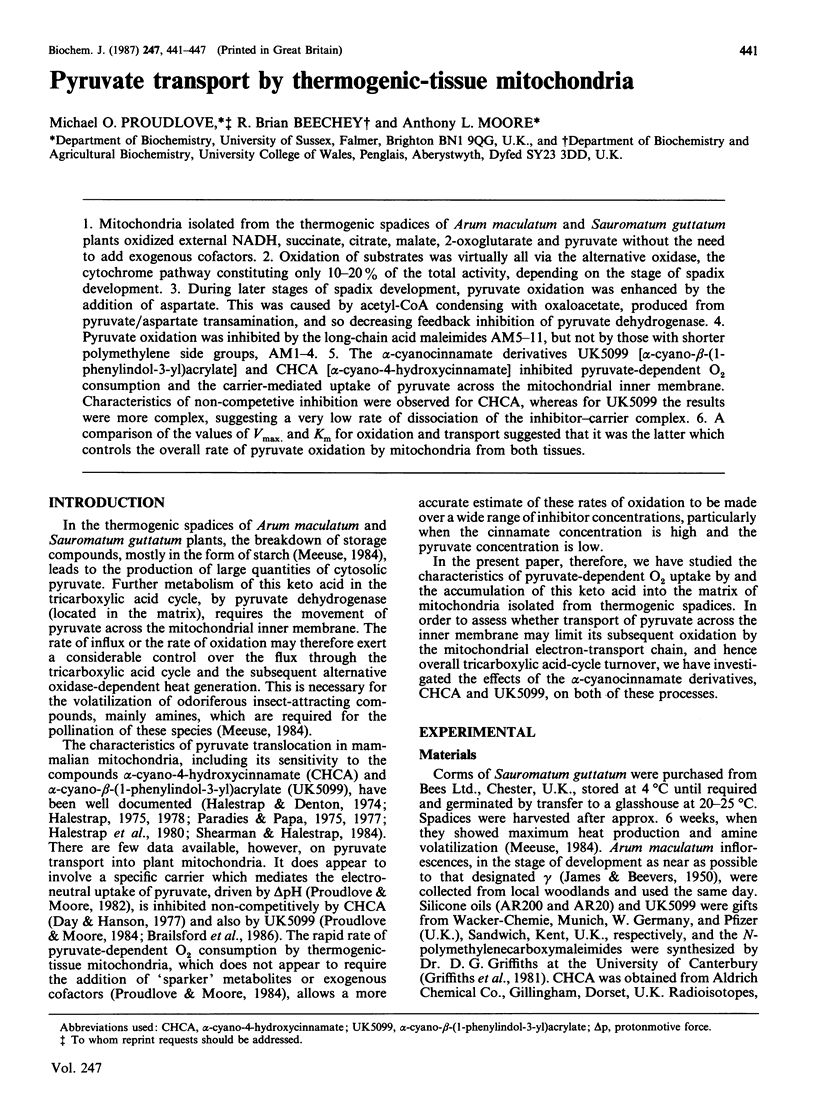
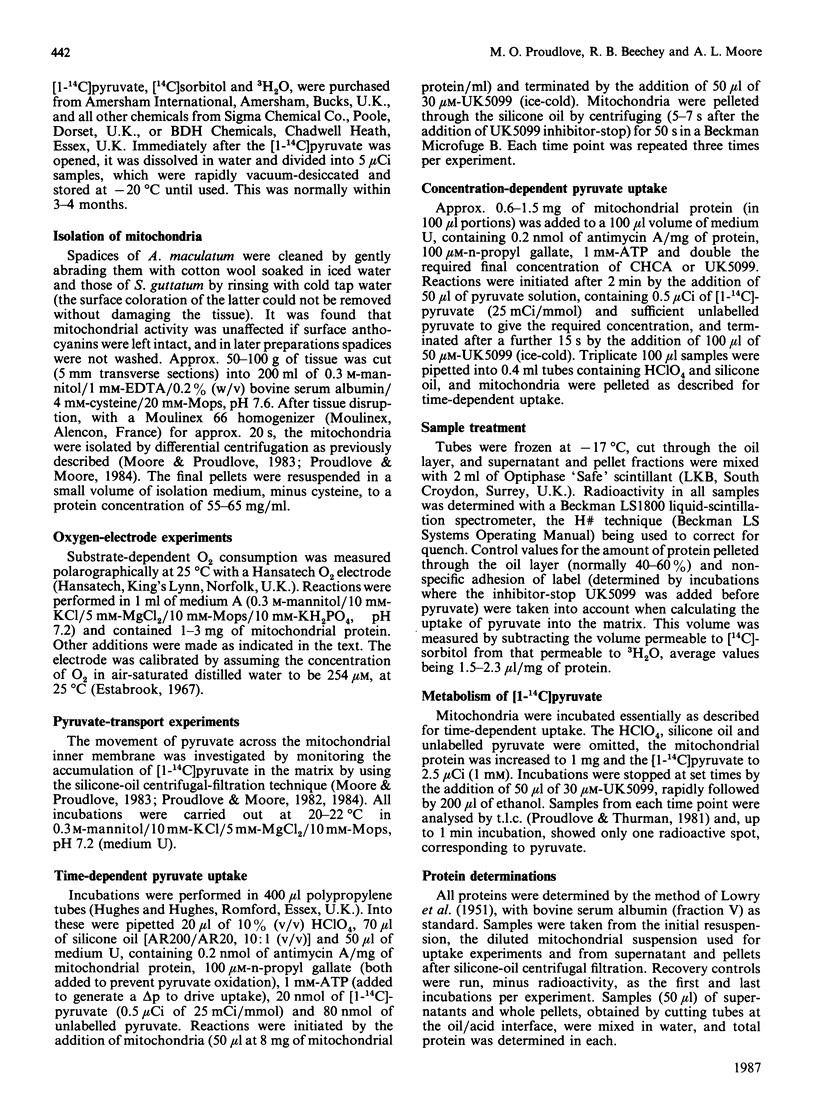
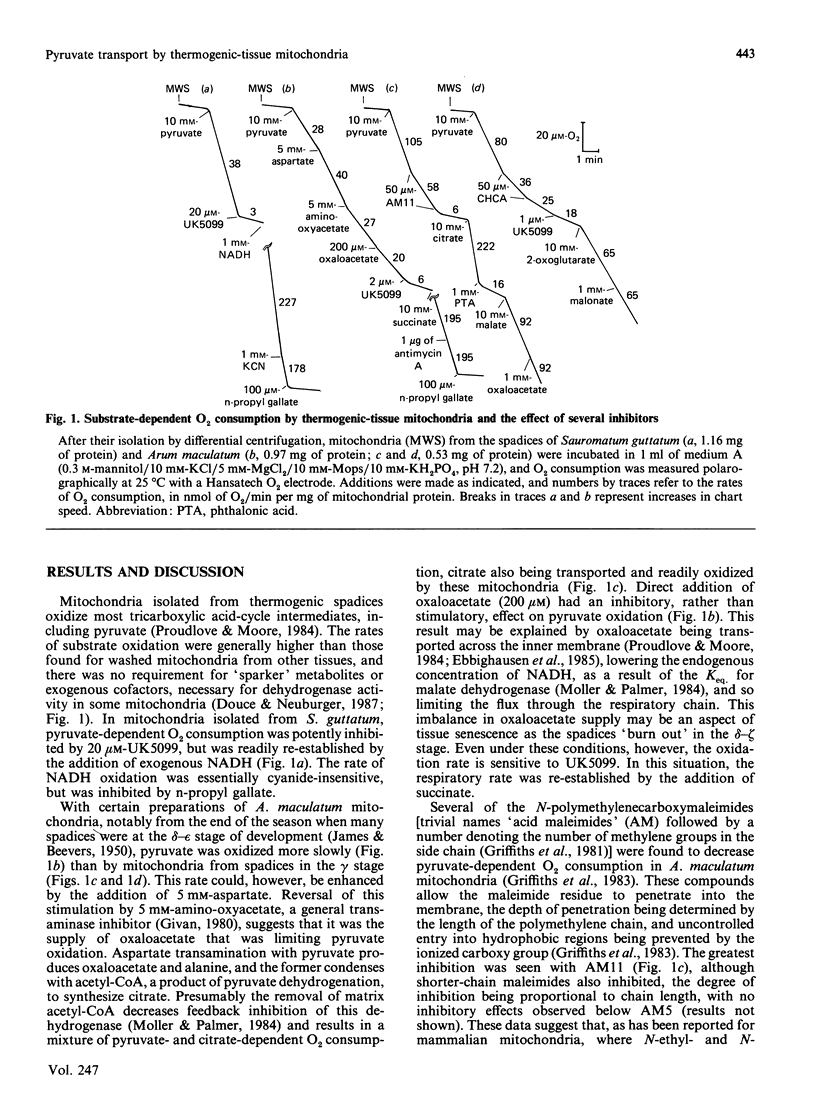
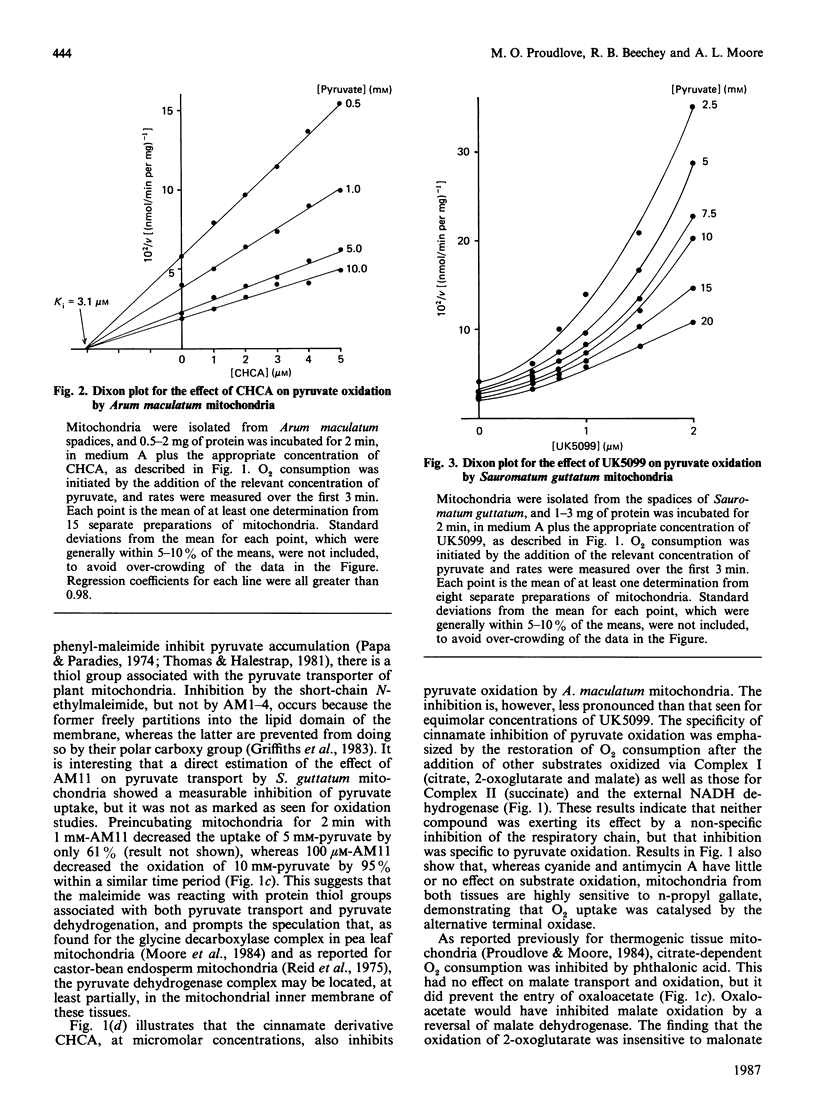

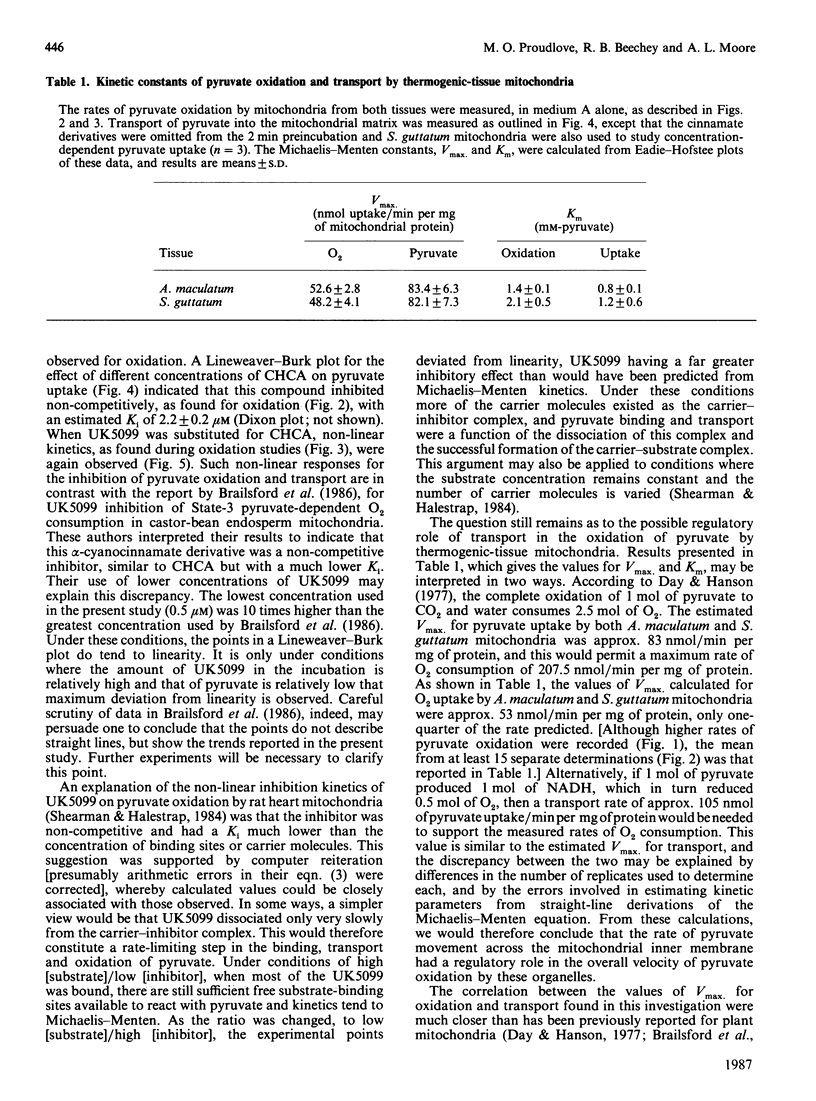

Selected References
These references are in PubMed. This may not be the complete list of references from this article.
- Brailsford M. A., Thompson A. G., Kaderbhai N., Beechey R. B. Pyruvate metabolism in castor-bean mitochondria. Biochem J. 1986 Oct 15;239(2):355–361. doi: 10.1042/bj2390355. [DOI] [PMC free article] [PubMed] [Google Scholar]
- Day D. A., Hanson J. B. Pyruvate and malate transport and oxidation in corn mitochondria. Plant Physiol. 1977 Apr;59(4):630–635. doi: 10.1104/pp.59.4.630. [DOI] [PMC free article] [PubMed] [Google Scholar]
- Griffiths D. G., Partis M. D., Sharp R. N., Beechey R. B. N-polymethylenecarboxymaleimides -- a new class of probes for membrane sulphydryl groups. FEBS Lett. 1981 Nov 16;134(2):261–263. doi: 10.1016/0014-5793(81)80615-1. [DOI] [PubMed] [Google Scholar]
- Halestrap A. P., Denton R. M. Specific inhibition of pyruvate transport in rat liver mitochondria and human erythrocytes by alpha-cyano-4-hydroxycinnamate. Biochem J. 1974 Feb;138(2):313–316. doi: 10.1042/bj1380313. [DOI] [PMC free article] [PubMed] [Google Scholar]
- Halestrap A. P. Pyruvate and ketone-body transport across the mitochondrial membrane. Exchange properties, pH-dependence and mechanism of the carrier. Biochem J. 1978 Jun 15;172(3):377–387. doi: 10.1042/bj1720377. [DOI] [PMC free article] [PubMed] [Google Scholar]
- Halestrap A. P., Scott R. D., Thomas A. P. Mitochondrial pyruvate transport and its hormonal regulation. Int J Biochem. 1980;11(2):97–105. doi: 10.1016/0020-711x(80)90241-4. [DOI] [PubMed] [Google Scholar]
- Halestrap A. P. The mitochondrial pyruvate carrier. Kinetics and specificity for substrates and inhibitors. Biochem J. 1975 Apr;148(1):85–96. doi: 10.1042/bj1480085. [DOI] [PMC free article] [PubMed] [Google Scholar]
- LOWRY O. H., ROSEBROUGH N. J., FARR A. L., RANDALL R. J. Protein measurement with the Folin phenol reagent. J Biol Chem. 1951 Nov;193(1):265–275. [PubMed] [Google Scholar]
- Papa S., Paradies G. On the mechanism of translocation of pyruvate and other monocarboxylic acids in rat-liver mitochondria. Eur J Biochem. 1974 Nov 1;49(1):265–274. doi: 10.1111/j.1432-1033.1974.tb03831.x. [DOI] [PubMed] [Google Scholar]
- Paradies G., Papa S. On the kinetics and substrate specificity of the pyruvate translocator in rat liver mitochondria. Biochim Biophys Acta. 1977 Nov 17;462(2):333–346. doi: 10.1016/0005-2728(77)90132-3. [DOI] [PubMed] [Google Scholar]
- Paradies G., Papa S. The transport of monocarboxylic oxoacids in rat liver mitochondria. FEBS Lett. 1975 Mar 15;52(1):149–152. doi: 10.1016/0014-5793(75)80659-4. [DOI] [PubMed] [Google Scholar]
- Reid E. E., Lyttle C. R., Canvin D. T., Dennis D. T. Pyruvate dehydrogenase complex activity in proplastids and mitochondria of developing castor bean endosperm. Biochem Biophys Res Commun. 1975 Jan 6;62(1):42–47. doi: 10.1016/s0006-291x(75)80402-5. [DOI] [PubMed] [Google Scholar]
- Shearman M. S., Halestrap A. P. The concentration of the mitochondrial pyruvate carrier in rat liver and heart mitochondria determined with alpha-cyano-beta-(1-phenylindol-3-yl)acrylate. Biochem J. 1984 Nov 1;223(3):673–676. doi: 10.1042/bj2230673. [DOI] [PMC free article] [PubMed] [Google Scholar]
- Thomas A. P., Halestrap A. P. Identification of the protein responsible for pyruvate transport into rat liver and heart mitochondria by specific labelling with [3H]N-phenylmaleimide. Biochem J. 1981 May 15;196(2):471–479. doi: 10.1042/bj1960471. [DOI] [PMC free article] [PubMed] [Google Scholar]


